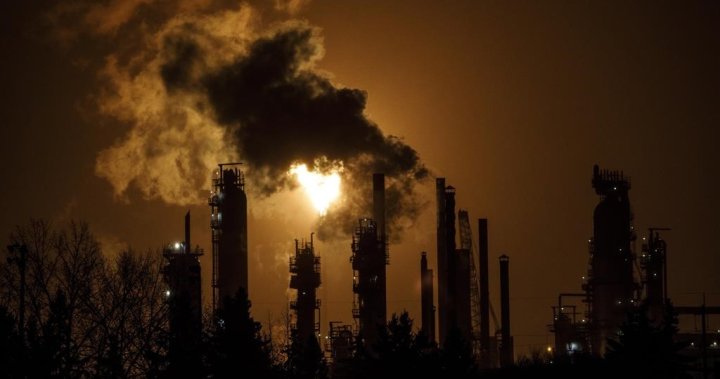In an effort to shore up her Alberta sovereignty within a United Canada Act, Premier Danielle Smith has claimed the federal government is using collected tax money to buy votes in the Eastern provinces and Albertans are suffering as a result – a claim experts say is just not true.
“We have set up a system where they tax us too much and then they dribble some money back to us if we will do our programs their way,” Smith said on 630 CHED’s Saturday Your Province. Your prime minister. “And then they take the rest and they use it to buy votes in Eastern Canada.”
But the reality is, all that money goes back to Alberta and is not spent by the federal government.
There are two parts to the federal carbon tax pricing system: the first includes a regulatory fossil fuel levy (which includes taxes on gasoline and natural gas) and the second is the output-based pricing system (OBPS), which is a performance-based system for industries.
Read more:
Alberta calls on federal government to stop carbon tax increase
Read more
-
![]()
Alberta calls on federal government to stop carbon tax increase
The federal fuel levy currently applies to Alberta.
Although there is an upfront charge for gas and diesel purchases, 90 per cent of the tax collected under the fuel levy is returned to Albertans every three months through direct deposit, said Trevor Tombe, a professor of economics at the University of Calgary, explained.
The 90/10 split on the federal fuel levy applies to every province and territory, Tombe said, except BC, which has a fully independent model.
The remaining 10 percent is currently being held by the federal government as they work to decide which sector that money will go into. But the government is currently leaning towards going after indigenous groups, farmers and targeted industry, Tombe said.
“What is done with this revenue is a federal choice,” Tombe said, adding that Smith may very well be “building up the idea of taking back control of the revenue.”
The second part of the federal carbon tax is that for industry, the policy for which each province can choose and create itself.

Alberta vs. Quebec
Smith has compared Alberta to Quebec — a province that has notoriously tried to secede and separate from Canada for decades — several times since she first started talking about the Alberta Sovereignty Act during the UCP leadership campaign.
But her comments hold little weight against the truth.
While Your province, your prime minister, Smith said the federal government is once again acting unconstitutionally by implementing more favorable policies in other provinces, which is why Alberta needs its sovereignty law.
“I almost fell off my chair when I had my courtesy call with Francois Legault, Premier of Quebec, and he said to me, ‘Oh, you know, we don’t have the same retail carbon tax as you do, because we have a cap -and- trading system and we are treated differently.’ I don’t think it’s constitutional,” Smith said on air.
Smith went on to say the nature of the problem is that Alberta is treated differently by the federal government than other provinces are – specifically Quebec.
“Because when we’re talking about passing unconstitutional laws, that’s exactly the kind of thing I’m talking about.
“The federal government adopts policies that treat us differently than other parts of the country, and then we have to go to court to say: Oh, well, you can’t do that under the Constitution.
“That’s the kind of thing that’s out of line is this kind of policy.”
The federal government does set the precedent by creating a benchmark, which “sets out the criteria that carbon pricing systems implemented by provinces and territories must meet,” according to the federal government.
However, provinces and territories can choose how they regulate carbon emissions charges.

“The purpose of the measure is to ensure that carbon pollution prices apply to a broad set of emission sources with increasing stringency over time to reduce GHG emissions at the lowest cost to business and consumers and support innovation and clean growth,” the federal government writes on its website.
Alberta, due to its vast oil and gas industry, has the largest amount of emissions of any other province or territory, with Ontario and Quebec trailing behind.
Ontario has the same framework setup as Alberta with a federal fuel levy and provincial OBPS, while Quebec has a cap and trade system.
Alberta’s provincial system meets the federal benchmark for its emissions. According to the federal government, provinces – such as Alberta – that have their own carbon pricing system (provincial OBPS) “use the proceeds as they see fit.”
Some of the revenue collected under the provincial plan is returned to industry through subsidies, some goes into funds used for energy innovation, and some goes to the Energy War Room – “a quasi-governmental PR- entity aimed at Alberta’s oil and gas development,” and was a campaign promise during the last provincial election, Tombe said.

The federal government has been clear since it launched Canada’s climate plan set in 2020 that the price on pollution would rise every year until 2030.
It is also revenue neutral, meaning that the government will return the money it collects from this tax to the public.
As for the cap-and-trade program that Smith said unfaired Quebec, Dale Beugin, vice-president at the Canadian Climate Institute, explained that since all the provinces have agreed to their current programs, they have a cap-and- trading system instead of a carbon levy or fee, as it is “within the rules of the original agreement defined by the Pan-Canadian framework.”
“A cap-and-trade system is going to define the number of emissions that are allowed into the system … So Quebec knows for sure what its emission levels will be. It doesn’t know for sure what its price will be,” explained Beugin.
“Alberta and the other provinces are the opposite. They know what the price will be. They achieve that price directly by setting that price directly.”
“They don’t know exactly what the emission levels will be as a result – it’s going to depend on market choices and how those firms choose to reduce emissions or pay the carbon price.”
Read more:
Alberta premier weighs changes to ‘clean up’ sovereignty bill amid concerns
Smith calls emissions cap ‘against the Constitution’
According to Smith, the federal government’s plan to place an emissions cap “that would force our oil and natural gas producers to reduce their emissions by 42 percent by 2030” is against the constitution.
She added that former energy and current environment minister Sonya Savage told Smith that “if you have an emissions cap and you don’t have the technology to meet it and you don’t have the time frame to be able to meet it no, it is a de facto production limit and it is against the Constitution.”
She went on to say, “we have the right to develop our resources to determine the rate at which we develop, our resources to develop conservation policy around that. And this is a violation of our rights.”
The purpose of the carbon tax is so that provinces can start initiatives that enable cleaner solutions, for less emissions and in general a healthier environment, said Beugin.
The money raised is intended to invest in cleaner solutions and energy production.
Read more:
Danielle Smith: You’re right if you think the carbon tax is a tax grab
“Whether it’s you as an individual filling up your car or a firm debating replacing their old equipment with new efficient equipment or implementing carbon capture and storage – they do those things because it’s more cost effective is to make those changes. take action to reduce emissions than it is to not and to pay the carbon price,” he said.
“This is how carbon pricing immediately creates incentives for reducing emissions.”
Beugin said it also sets future expectations that it will be worth investing in things that make decarbonisation more efficient and cheaper in the long run.
“These output-based pricing systems in place across the country are expressly designed to maintain that incentive to reduce emissions by improving performance.”
Your Province. Your prime minister is broadcast on 630 CHED and 770 CHQR, which is owned by Corus Entertainment – the parent company of Global News.






